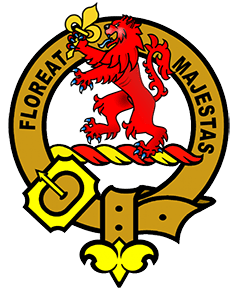Brown Clan
Brown Clan Crest: A lion rampant holding in it's paw a fleur-de-lys.
Brown Clan Motto: Floreat Majestas (Let majesty flourish).
Brown Clan History: The Brown, or Broun surname, as it was often spelled, is very common throughout Scotland and in most instances is a simple reference to the colour brown, as in brown hair, or eyes. The name in Scotland is thought to be French-Norman in origin and was found most commonly in the East of the country. There is a suggestion of a Celtic origin for the Brown surname in the Western Isles, taken from the Gaelic word "brehons", meaning Judge.
The surname is first recorded in Scotland when Sir David Le Brun, in 1128, witnessed the foundation charter of Holyrood Abbey in Edinburgh. Between 1194 and 1214 Patric Brun witnessed resignation of land at Warmanbie in Annandale. Several Brun's of Edinburgh and Berwick are recorded as signing the Ragman Roll of 1296 when the Scottish nobility were forced to swear allegiance to King Edward I. William Brun, son of John de le Brune, burgess of Dundee, is recorded as having signed several charters in the early 1300's. Joannes Broun, High Sheriff of Aberdeenshire, was granted the thanage of Formerteine by Robert the Bruce. David Broun, of St. Andrews, in 1433, is recorded as taking instruments on his being robbed of a sheepskin at the Cross of Cupar-Fife by Alexander de Kinloch and David de Kilmarone.
The Brouns of Hartrie, in Lanarkshire, were first recorded as holding lands there in 1376.
The Brouns of Colstoun, thought to be the heads of the family, were in possession of the lands of Colstoun in the mid-1500s, and are said to have held them for some 300 years previously. The Brouns of Colstoun claim descent from the French Royal Line, their arms feature three gold fleur-de-lys, an emblem particularly associated with the French monarchy.
A famous Broun family legend concerns the "Colstoun Pear" which was taken from its tree by Sir Hugo de Gifford, the 13th century wizard of Yester castle, as a wedding gift for his daughter, Margaret, on her marriage into the Broun family. Sir Hugo said as long as the pear was kept safe all would be well with the Brouns of Colstoun. The family had a silver box made to preserve the pear, and fortune favoured the family.
More than four centuries later, in 1692, Lady Elizabeth Mackenzie married Sir George Broun, son of Sir Patrick Broun of Colstoun, Baronet of Nova Scotia. On her wedding night, she dreamed she had taken a bite from the Colstoun pear. The dream was regarded as a portent, and the family expressed great fear that the bride would bring bad fortune upon them.
Misfortune did follow, when George Broun ran up massive gambling debts, and had to sell the Colstoun estate to his younger brother, Robert Broun.
Robert drowned, along with his two young sons, whilst travelling to Colstoun from Edinburgh, when a flash flood caused a stream to burst its banks, sweeping them to their deaths. In 1718 George died, almost destitute, along with his wife Elizabeth. The family was left without a male heir and the estate went to a daughter, Jean Broun, whilst the title, went to the Broun's of Thornydyke as the only male branch of the family.
Members of a younger branch of the Colstoun Brouns settled in Denmark and France, where they became prominent in commerce and the military.
Places of Interest: Bruntsfield House, Edinburgh. 16th century tower house, built on an earlier fortress, which was named after Richard Broun, who held the property in the 1300s. "Broun's Field" became known as "Bruntsfield". Carsluith Castle, Carsluith village, Galloway. 15th century tower house owned by the Brouns from the early 1500s until the mid-1700s when they sold the property to the Johnstones and emigrated to India. Colstoun House, near Haddington, Lothian. The 16th century seat of the family, held by the Browns from the 1200s. The mansion, a listed building, and the 1400 acre estate, are in the private ownership of the Broun-Lindsay family of Colstoun. The mansion features an ornamental 18th century ceiling in the drawing room. Important early Scottish medieval pottery kilns have been found within the estate grounds. Lindsaylands House, near Biggar, Lanarkshire. Mansion house built in the 1650s and owned by the Brown family for several centuries. Midmar Castle, Echt, Aberdeenshire. 16th century castle built on an earlier stronghold. Held by the Browns from the 1200s until 1422 when it went to the Gordons.
Surname distribution in Scotland: The highest concentration of people with the Brown surname is in Angus (Forfarshire), Dundee City, Fife, Edinburgh and the Lothians, Stirlingshire, Falkirk, Clacks, Lanarkshire, Dumfries and Galloway (made up of the historic counties of Dumfriesshire, Kirkcudbrightshire and Wigtownshire), Ayrshire and the Scottish Borders (Berwickshire, Peeblesshire, Roxburghshire, Selkirkshire and part of Midlothian).

